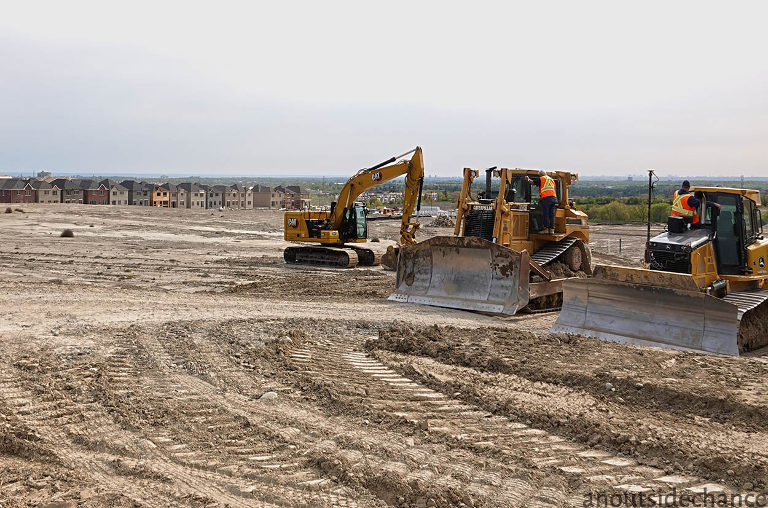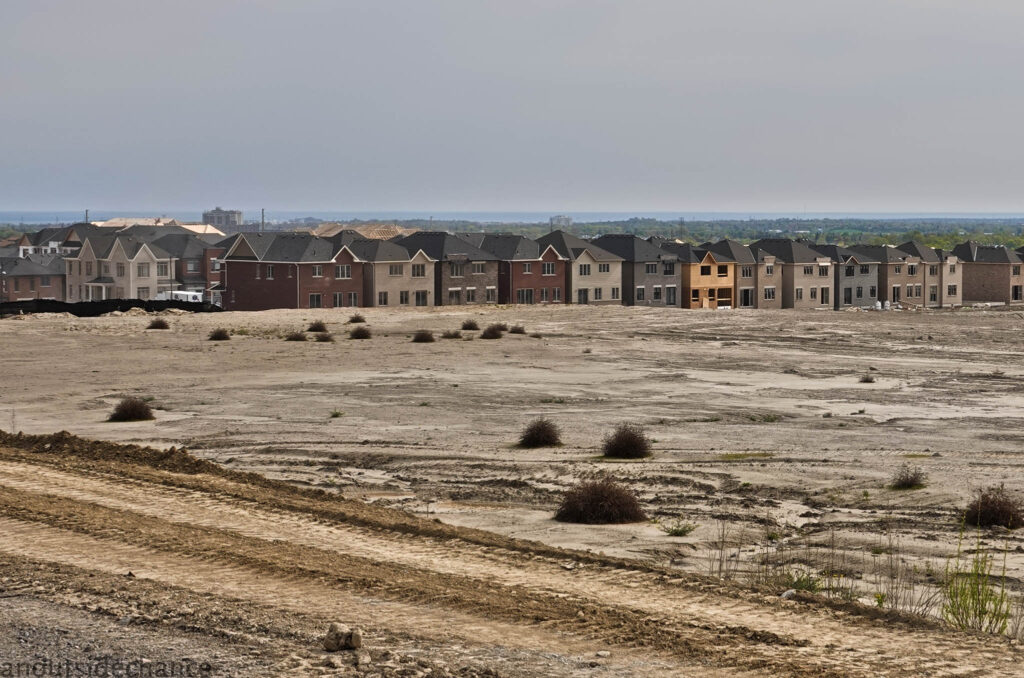Car-dependent neighbourhoods arise in a multi-level framework of planning, subsidies, advertising campaigns and cultural choices. After that, car dependency requires little further encouragement. Residents are mostly “locked-in”, since possible alternatives to car transport are either dangerous, unpleasant, time-consuming, or all three.
At the same time, municipal officials have strong incentives to simply accept car dependency – it takes bold new thinking to retrofit such neighbourhoods. Voters are likely to resist such new directions, since it is hard for them to imagine making their daily rounds using anything except private cars.
This post continues a discussion of what car dependency looks like on the map. The previous installment looked at car dependency on a regional scale, while this one looks at the neighbourhood scale.
Both posts use examples from Durham Region, a large administrative district on the east flank of Toronto. With a current population of about 700,000, Durham Region is rapidly suburbanizing.
I’ve picked one neighbourhood to illustrate some common characteristics of car-dependent sprawl. I have chosen not to name the neighbourhood, since the point is not to single out any specific locale. The key features discussed below can be seen in recent suburban developments throughout Durham Region, elsewhere in Ontario, and around North America.
Let’s begin to zoom in. In the aerial view below you can see new subdivisions creeping out towards a new expressway. Brown swatches represent farmland recently stripped of topsoil as the first step in transforming rich agricultural land into suburban “development”. (In the short time since this aerial imagery was obtained, the brown swatches have become noticeably more extensive.)
The neighbourhood we’ll focus on includes a high school, conveniently identifiable by its distinctive oval running track.
Subdivisions here are built in a megablock layout, with the large-scale grid intended to handle most of the traffic. Within each megablock is a maze of winding roads and lots of dead-ends. The idea is to discourage through traffic on residential streets, but this street pattern has many additional consequences.
First, from the centre of one megablock to the centre of another nearby megablock, there is seldom a direct and convenient route. A trip that might be a quarter of a kilometer as the crow flies might be a kilometer or two as the car drives. In the worst areas, there are no available short cuts for cyclists or pedestrians either.
Second, the arterial roads need to be multilane to cope with all the traffic they collect – and as “development” proceeds around them they are soon overwhelmed. “Recovering engineer” Charles Marohn explains this phenomenon using an analogy from hydrology. At a time of heavy rain, a whole bunch of little streams feed into progressively larger streams, which soon fill to capacity. With a pattern of “collector” roads emptying into secondary arterial roads into primary arterials and then into expressways, suburban road systems manage to engineer traffic “floods” each time there is a “heavy rain” – that is, each morning and afternoon at rush hour.1
As we zoom in to our high school’s neighbourhood, note another pattern repeated throughout this region. Within a residential neighbourhood there may be a row of houses close to and facing an arterial road. Yet these houses are on the equivalent of a “service road” rather than having direct access to the arterial. For motorists living here the first stage of a journey, to the arterial road just 50 meters from their driveway, requires driving ten times that far before their journey can really begin. Though the maze pattern is intended to limit traffic in such neighborhoods, residents create a lot of traffic simply to escape the maze.
The residential service road pattern has the effect of making arterial roads into semi-controlled-access roads. As seen in this example, there are few driveways or other vehicle entry points in long straight stretches of such an arterial. This design encourages drivers to drive well above the posted 60 km/hr speed limit … whenever the road is not clogged with rush-hour traffic, that is.
High traffic speeds make crossing such roads a dangerous undertaking for pedestrians and cyclists. True, there are some widely-spaced authorized crossing points, with long waits for the “walk” light. But when getting to and waiting at a crosswalk is not convenient, some people will predictably take their chances fording the rushing stream at other points. How many parents will encourage or even allow their children to walk to school, a playground, or a friend’s house if the trip involves crossing roads like these?
Just across the road. High school is on the left of the road, residential neighbourhood to the right.
Pedestrian access is at best a secondary consideration in such developments. Consider the aerial view below.
Directly across one arterial road from the high school, and across another arterial from a residential neighbourhood, is a cluster of big box retail stores including a Walmart Supercentre. The Walmart has 200 meters of frontage on the street, but in that stretch there is no entrance, nothing but concrete wall to greet the occasional lonesome pedestrian.
From another direction, many people live “just across the street” from the Walmart and other stores. Except … would-be pedestrian shoppers will need to cross not just a multilane urban highway, but also hectares of parking lot, before reaching the doors of a store. These stores are large in retail floor area, but they are dwarfed by the land given to parking. In accord with minimum parking requirements, the stores have spent hundreds of thousands of dollars to provide “free parking”. But there is no requirement to take the convenience of pedestrians into account. The doors open to the parking lots, not to the streets, because the vast majority of shoppers will arrive in large private vehicles that will need to be stored somewhere while the owner goes shopping.
Nevertheless there will be a small minority in such neighbourhoods who get to the store on foot or on bike. A few might be brave, stubborn environmentalists or exercise freaks. But mostly they will be people who can’t afford a car, or who can’t drive because of some type or degree of disability. Disproportionately, they will be elderly and/or in poor health. Particularly when carrying heavy bags of groceries, they will not want to go far out of their way to get to a crosswalk, preferring instead to make the shortest straightest trip home. It is not an accident that high-volume arterial roads in suburbs account for a large proportion of pedestrian deaths in North American cities. It is not an accident, either, that a disproportionate number of these deaths are inflicted on elderly, disabled, poor, or racially disadvantaged pedestrians.2
Lamp posts
Out beyond the beyond
It is now widely recognized that car-dependent suburbia hurts public health via an increase in diseases of sedentary lifestyle and due to the stress of spending many hours a week in alternately frenetic and creeping traffic.3 The environmental costs of sprawl include high carbon emissions, impermeable ground covering that rapidly flushes polluted run-off into diminishing areas of creeks and wetlands, and urban heat-island effects from so much concrete and asphalt. Particularly in Ontario, new tracts of car-dependent sprawl can only be built with the sacrifice of increasingly scarce class one farmland.4 Finally, groups such as Strong Towns have documented the long-term fiscal disaster of suburban development.5 Even though higher levels of government typically pay much of the initial cost of major infrastructure, municipalities will be on the hook for maintenance and eventual rebuilding – and property taxes in low-density suburbs seldom bring in enough revenue to cover these steadily accruing liabilities.
Yet in Ontario the large property developer lobby remains as strong a political force as ever. The Premier of Ontario makes no real attempt to hide his allegiance to the largest property developers.6 In Durham Region, after a long public consultation process recommended intensification of existing urban areas to accommodate growing populations, politicians suddenly voted instead for a sprawl-expanding proposal put forward by the development industry lobby.7
So in 2023, corn fields and pastures beyond the current edge of suburbia are being bulldozed, new maze-like streets laid out, thousands of big, cheaply-made, dearly-purchased, cookie-cutter houses stuffed into small lots. For a brief period new residents can look through the construction dust and see nearby farmland or woodland – until the edge of suburbia takes the next step outward.
Suppose you believe, as I do, that this ruinous pattern of development should not and cannot last – that this pattern will not survive past the era of cheap energy, and will not survive when its long-term fiscal non-sustainability results in collapsing services and municipal bankruptcies. When car culture sputters, falters and runs off the road, can these thousands of neighbourhoods, home to millions of people, be transformed so they are no longer car dependent? That’s a big question, but the next post will offer a few ideas.
For today, the edge
Image at top of page: Bulldozertown (click here for full-screen image). All photos used here are taken in the same area shown in satellite views.
Notes
1 Charles Marohn, Confessions of a Recovering Engineer, Wiley, 2021; pages 85–87.
2 For analyses of trends in pedestrian deaths, see Angie Schmitt’s 2020 book Right of Way (reviewed here), and Jessie Singer’s 2022 book There Are No Accidents (reviewed here).
3 See “Suburbs increasingly view their auto-centric sprawl as a health hazard,” by Katherine Shaver, Washington Post, December 28, 2016.
4 “Ontario losing 319 acres of farmland every day,” Ontario Farmland Trust, July 4, 2022.
5 See “The Growth Ponzi Scheme: A Crash Course,” by John Pattison, strongtowns.org.
6 See The Narwhal, “Six developers bought Greenbelt land after Ford came to power. Now, they stand to profit,” November 17, 2022; BlogTO, “All the crazy details about Doug Ford’s controversial stag and doe party with developers,” February 9, 2023.
7 See The Narwhal, “Ontario’s Durham Region approves developer-endorsed plan to open 9,000 acres of farmland,” May 26, 2022.












